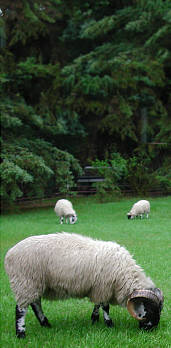
this page last updated Sep 11/10
2010 Update

PO Box 200 . Amisk, AB . T0B 0B0 (780) 856-3738 mail@nordinfarms.com |
|
Caseous Lymphadenitis
|
|
Caseous lymphadenitis (CL) is a chronic, infectious and
contagious disease of sheep and goats caused by the bacterium
Corynebacterium pseudotuberculosis that results in abscesses
of the lymph nodes and less frequently of internal organs.
Some sheep are more suseptible than others. Some can carry the bacteria without ever being affected by it; some will be chronically afflicted by it. But, once exposed to the bacteria (including simply being with another sheep that has been exposed), a sheep must be considered infected. |
|
2010 Update
|
|
Good News
There is a new type of penicillin available that is more effective in treating CL. I use ProcPen LA, but the key is not the penicillin, which has always been effective. It's the carrier that is better at penetrating the thick pus in which the CL bacteria grow. Previously, penicillin has only been available as an aqueous solution which required refrigeration. Now; however, there are brands which do not require refrigeration, and which I believe are oil based. This newer penicillin can be injected directly into an abscess with amazing results. The method I use is to first inject the sheep with the normal dosage based on weight. Then I inject 1/4 to 1/2 cc (depending on the abscess size) directly into the abscess. Inject from the top as much as possible, so the penicillin doesn't run/drip out. I have found that the abscess will dry up and either disappear or harden and slowly be reabsorbed. The advantage is that, because you don't have to lance the abscess, the bacteria remains contained until it is dead and is less likely to spread. In most cases, one injection is all it takes; however, I would recommend running the full course of systemic treatment for the sheep. |
|
2008 Update
|
| Since we began managing the disease, we have seen a steady decline in the expression of CL among our flock. I am pleased to report that this spring we did not find a single case (shearing time being the most revealing). |
|
How did our sheep get CL?
|
|
The disease came with our sheep and remained dormant for
several years before exhibiting clinical signs in a few ewes in 2004.
Originally we thought it was due to a problematic feeder we had. We treated the abscesses appropriately and removed the feeder. Then when we saw a couple more absesses appear the following year long after we had removed the suspect feeder, we had tests run. |
|
CL Management
|
|
After lab tests confirmed the abscesses we found were due to CL
we began managing the disease by vaccinating with
Glanvac, and due to availibility have now switched to Caseous-DT (Colorado Serum Co).
We treat affected sheep in isolation and cull afflicted ewes.
Just to give you some scope to this issue, very few of our sheep have had CL abscesses. Now that we are aware that our flock has been exposed and have begun management, we have seen not only the number of cases decrease, but the occasional absess we do see is small and superficial. |
| In addition to vaccination, we also sanitize shears between sheep, burn suspect bedding (especially if an absessed sheep occupied the bedding during treatment). We have also changed to a different watering system because we observed sheep rubbing their faces on our previous livestock tank. In our new set-up, sheep cannot rub on it and potentially spread the bacteria. |
|
So why still sell breeding stock?
|
|
Because there are so few Scottish Blackface
sheep in Canada, and even less registered stock,
we still sell them in an attempt to
keep this breed alive.
We do not sell sheep which have exibited clinical signs of the disease as breeding stock. If you require CL-free sheep, please contact another Scottish Blackface breeder. Be sure to ask about CL when making your enquiry. |
|
Where can I learn more?
|
|
Some shepherds are unaware of CL, so abscesses may be passed off as
simply caused by eating thistles or other sharp forage; admittedly, our first thought.
While this may be the case, only a lab test can tell for sure.
If you suspect you have CL, or want to be prepared, here are two valuable links: Caseous Lymphadenitis - Onion Creek Ranch This site focuses on goats, but the same generally applies to sheep. It is a detailed site including illustrations of abscess sites, treatment and control, and a discussion on other causes of abscesses. Note: Currently there is no vaccination for goats and this is reflected in the emphasis of the above site. Caseous Lymphadenitis in Alberta Sheep An informative publication with a more technical slant. What I found interesting was that "...mature sheep and lambs from industry flocks without previous CLA control programs, also had a high incidence of exposure to [CL]; 54 to 94% and 11.4 to 22.9%, respectively. Lambs from industry flocks with previous CLA control programs had a lower incidence... of exposure to [CL] (range 2.6 to 9.7%)." |